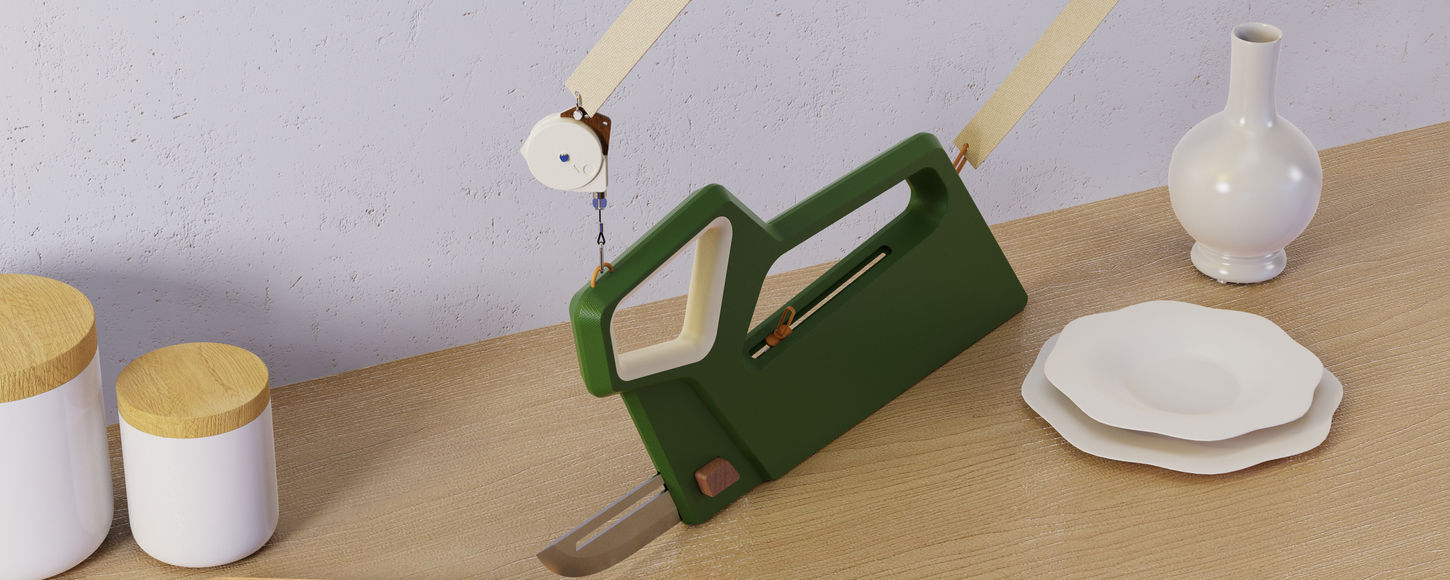PRODUCT DESIGN 3
2023 FALL
FlexiEase Knife Assist Tool

FEATURE
About Disability.
"Viewing disability not as a loss but as a unique experience.
Embracing the differences instead of "normalizing" or "fixing" the differences."
In this project, the goal is to design a product within the category of Motor Disability.
- Motor impairment is the partial or total loss of function of a body part.
- Accessibility equipment: it can be used equally and conveniently by everyone.
My focus is on individuals experiencing upper limb deficiency, a motor disability that significantly hinders the convenience of everyday tasks. This device is an innovative solution designed to empower individuals with hand disabilities to perform cutting tasks independently.

FlexEase is a wearable knife designed to make cutting tasks easier and safer for people with upper limb disabilities.
It hangs from the body using a shoulder strap, with the arm sliding through a soft front opening to control the blade. A retractable elastic cord connects the product to the strap, providing tension and making it easier to pull and release the knife during use. With thoughtful ergonomic design and a focus on comfort, FlexEase helps users perform everyday cutting tasks with more independence and less effort.



New wearable knife design, more tailored to diverse users
Retractable blade
Can be hung on the wall for more convenient access and wear.
The blade is protected by a casing, preventing harm to the user.
Replaceable blade design, adaptable to different usage scenarios.



Challenge.
Our hands bring us many conveniences.
But please don't ignore that there is a group of people with different life experiences.
- Difficulty in Mobility and Manipulation
- Communication: Type/Writing
- Economic Challenges
- Entertainment


Component & Material Breakdown



Maria
Stay-at-home Mom
Age: 38
Occupation: Stay-at-home mom
Motor Disability: Born with a congenital limb difference
Goals:
To prepare daily meals for her family with ease
To engage in the family's kitchen activities without feeling limited.
Challenges:
Handling hot cookware while managing other tasks
Performing tasks that typically require two hands, like opening jars or cutting vegetables.
Needs:
A tool that is versatile for different kitchen tasks and can be operated with one hand
A design that is safe and stable, preventing accidents in the kitchen
Elena
Chef and Culinary Inspirer
Persona

Age: 34
Occupation: Chef and Culinary Inspirer
Motor Disability: Upper limb loss due to a tragic incident
Goals:
To create and share inspiring dishes that reflect her cultural heritage and personal journey.
To advocate for more accessible and inclusive kitchen designs and culinary tools.
To teach and empower others with disabilities to pursue their culinary dreams.
Challenges:
Manipulating traditional kitchen tools and equipment designed for hand use.
Ensuring safety and precision in food preparation, cooking, and presentation.
Overcoming physical fatigue from using her arms and shoulders extensively.
Needs:
Custom-designed kitchen tools that accommodate the absence of hands, allowing for secure attachment to her arms.
Ergonomic designs that reduce strain on her shoulders and back.
Interview - Need?
User-Friendly Appliances: Appliances that can be operated without hands, possibly through foot controls, voice commands, or elbow-operated mechanisms.
Safety Features: Incorporation of safety measures, especially around sharp objects and hot surfaces, to prevent injuries.
Accessible Design: Adjustable heights for counters and appliances, and easy-to-access storage solutions like sliding drawers.
Specialized Tools: Adapted kitchen tools and utensils that can be used without a traditional grip, designed for ease and safety.
Stable Preparation Surfaces: Non-slip surfaces and secure food-holding mechanisms for safe and efficient food preparation.
Low-Maintenance and Cleanliness: Surfaces that are easy to clean and maintain, and designs that minimize cleaning effort.
Mobility-Friendly Layout: A spacious layout to accommodate different types of mobility, ensuring easy movement within the kitchen.






Market Research
- Most of the products are one-handed operations.
- Lacking protection.
- Lacking adaptability.
- Lacking ergonomics.
- Lacking aesthetic appeal



User-Scenarios Learning
I began by observing the daily knife usage of an disability chef with no hands, learning the most efficient way to handle a knife for individuals with disabilities who do not have palms. Subsequently, I studied the knife usage methods that best conform to ergonomics. After much research, studying and observing, I decided to create a wearable knife by combining users' existing habits with adjustments based on ergonomic design



During the design process, adhering to the concept of inclusive design, I considered a series of issues. For instance, the shape of the blade, the overall shape's compatibility with ergonomics, the position of the handle, the connection point to the strap, and the placement of the blade. Ultimately, I arrived at the final shape that I wanted to create.
CMF
Exploration













